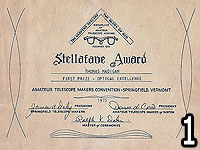
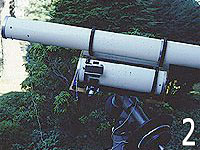

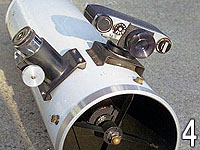



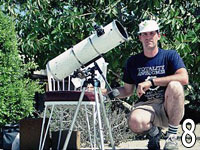
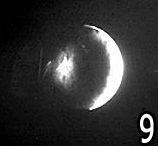
|
by Thomas Madigan of New York
2000-Oct-19
My father was instrumental in fostering and nurturing my interest in astronomy since my early
childhood. I can still remember those early evenings during the late 1950's when he would take me out on the
sidewalks of the upper west side of Manhattan and point out the old favorites such as Orion, the Pleiades,
Sirius, etc. Back then you could still see the night sky from New York City. This early exposure gave me an
indelible and life-long interest in astronomy. I was on my own pursing astronomy until the spring of 1973 when
my father brought me to my first meeting of the Astronomical Society of Long Island, which met then at the
Vanderbilt Planetarium. The Planetarium would become my home away from home as it were, for the next ten years.
It would first be a place to go to learn as much as I could about astronomy and as a focal point for my
involvement in the ASLI, then as my place of employment for the next 7 years as associate astronomer, lecturer
and technician.
My first visit to Stellafane was 1974. Stellafane was then and still is today, the Mecca for
amateur astronomers in the northeast and I was no different than any other amateur in that the trip to
Stellafane was the high point of the Summer. When Stellafane came to a close one year, we were busy planning
next years trip to Springfield, Vt. I was moved by the philosophy embodied in what is "Stellafane", first began
by Russell W. Porter and inscribed on the club house walls "The Heavens declare the Glory of God". This
philosophy holds that with your own hands you could fabricate and engineer your own instrument to explore the
heavens first hand.
With the inspiration and encouragement of my father and fellow colleagues at the Vanderbilt
Planetarium, I set out to build my first telescope. Albeit, this was not my first telescope per se, it was the
first one where I fabricated the primary optical component, a 6" (150 mm) F/4.2 paraboloid. Using the 3 volume
set of Scientific American's "Amateur Telescope Making" and Allyn J. Thompson's "Making your Own Telescope", I
set about the task of producing my first telescope mirror. As expected, progress was slow with much care taken
in following the instructions and prescriptions in the books on hand. To test the optic, I used a home-modified
Foucault tester obtained from A. Jaegers of Lynbrook, NY. Approximately 7 months later and 4 months before
Stellafane, '75, the final polishing and figuring strokes were taken and the element was complete. During these
final stages of figuring, it was necessary to bear in mind that the focal ratio was half the usual ratio of F/8,
normally recommended for first attempts at mirror making.
Once complete, I set about mounting the mirror in a suitable tube and support system.
Standard, commercially available components were chosen for this. A white fiberglass tube and aluminum mirror
cell were chosen. Over time these components were modified to support both a photographic and visual agenda. The
standard length adjustment screws in the mirror cell were replaced with extra long adjustment screws to
facilitate the changing of the lateral placement of the primary mirror in the tube. This to accommodate a camera
mount, mounted 90 degrees from the visual focusing rack. The camera mount allowed for the placement of "T"
adapter for my Miranda Laborec camera modified to allow for prime focus photography using the first focus, knife
edge test for focusing. This method of focus was chosen for photography since image degradation due to poor
focus is an inversely proportional, non-linear function of the focal ratio and the focal ratio of this
instrument is approx. 4. To accommodate either the visual or photographic modes, the secondary mirror mount is
rotated 90 degrees accordingly and the primary mirrors' lateral placement in the tube is changed.
My primary reason for building this and all subsequent telescopes is the thrill of exploring
the heavens with an instrument of my own making. As an afterthought and after much prodding, I was convinced by
my friends and colleagues to enter this, my first telescope a 6", F/4.2 Richest Field Newtonian in the Optical
competition at Stellafane. After the 2nd and 3rd place winners in the Optical Excellence category were
announced, I resigned myself to the fact that I wasn't going to take home a prize. When they announced my name
as First Place winner for Optical Excellence, I practically fell over where I stood. It came as a complete
surprise. From that point forward, I was given the honor of being a judge of telescopes at every Stellafane
convention. An honor that I appreciate to this day, over 25 years later. I have since produced many more
telescopes and optical systems, including a 6" f/12 used as the primary visual guider for the astrophotos
included with this site and pictured in tandem with the featured RFT. This telescope produces stunning views of
the Moon, Jupiter and Saturn and is a great telescope in its own right. In addition, I've produced several more
6" and 8" Newtonians for myself, friends and relatives and am currently working on a 12.5" when time permits.
This telescope has accompanied me on all subsequent trips to Stellafane as well as other
trips of an astronomical nature. Among these trips was an expedition to Cabo San Lucas, Mexico to observe and
photograph the Solar Eclipse of 11 July, 1991. An animated sequence using photographs obtained at the prime
focus of this telescope can be found at: Eclipse Animation sequence. In addition, the return of Comet Halley was
observed from the Florida Everglades using this instrument.
This focogram was taken at the 70 % zone of the mirror's radius and illustrates the classic paraboloidal
shadows associated with the Foucault knife edge test. Some minor surface defects can be detected. Before the
optic was declared complete, a more rigid test was conducted subsequent to the exhaustive Foucault series using
the un-coated element, a knife edge at the first focus and Vega as the light source. Seeing and observing
conditions not withstanding, a null image with no shadows was observed.
Photo Captions:
- 1975 Stellafane Competition Award.
- RFT w/ 6" f-12
- RFT at photo first focus.
- Configured for photography.
- View showing optic.
- View of custom adjusting bolts.
- On location in Cabo.
- Thomas Madigan and his telescope.
- Focogram (No larger image available)
|